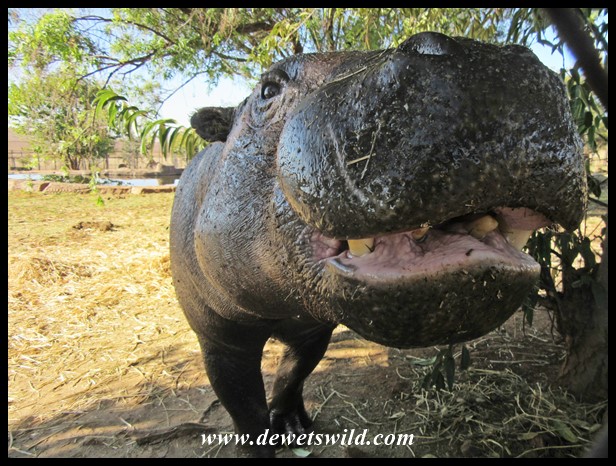Today, on Endangered Species Day, we feature another African mammal that isn’t indigenous to South Africa.
Choeropsis liberiensis
With an adult population in the wild estimated at no higher than 2,500 animals and still declining, the IUCN considers the Pygmy Hippo to be an endangered species. The biggest threats to their continued existence is hunting and the destruction of their forest habitat, with only a small proportion of the remaining population being found inside formally protected reserves and most of it being restricted to ever shrinking and increasingly isolated pockets of natural habitat. Today, wild populations are found in only four neighbouring countries in West Africa: Guinea, Sierra Leone, Liberia and Côte d’Ivoire. An isolated population in Nigeria probably went extinct in the 1940’s. An internationally coordinated captive breeding programme for the species holds about 380 individuals in facilities across the world, including here in South Africa.
As its name suggests, the Pygmy Hippo is much smaller than the only other extant species of hippopotamus, the Common Hippo. Adult males weigh up to 280kg, females up to 190kg, and they stand only 70-90cm high at the shoulder. While they live in close association with fresh water in lowland and swamp forests, the Pygmy Hippo spends much less time in the water than its larger cousin. They feed on swamp plants, leaves, roots and fruit (grass is the main fodder for the Common Hippo, but is in short supply in the forests the Pygmy Hippo inhabits). Pygmy Hippos are solitary, nocturnal creatures and the only associations are of mating couples or a cow and her single offspring, born after a 7 month gestation. Despite their comparatively diminutive size, Pygmy Hippos are aggressive and quite dangerous when cornered or wounded.












Dis interressant. Oulike ou dingetjie.
LikeLiked by 1 person
Ek dink ook so, Elsabe. Dankie!
LikeLiked by 1 person
I never even knew that these existed! I know some people are saying they’re ugly, but I honestly think they’re really cute. Thank you for the post!
LikeLike
Glad we could introduce you to the pygmy hippo, and welcome here too!
LikeLike
A face only a mother could love!
LikeLiked by 1 person
Oh, and they do Kathy! I wouldn’t dare get between a mom and her baby, even if they’re a pair of pygmy hippos!
LikeLiked by 1 person
So ugly it’s cute. ☺️
LikeLiked by 1 person
We have that same saying in Afrikaans!
LikeLiked by 1 person
Ek kan amper nie glo dat hierdie outjies (soort van) plat kan le nie … maar op van jou foto’s lyk dit tog of hulle dit regkry 😉.
LikeLiked by 1 person
Kort beentjies help natuurlik daarmee! 😀
LikeLiked by 1 person
😄
LikeLike
wAAR HET JY DIE FOTOS GENEEM? Ek kan onthou dat die Wildteelsentrum op Potties een gehad het.
LikeLiked by 1 person
Die foto’s het ons by die Rhino & Lion natuurreservaat en die dieretuine in Pretoria en Johannesburg gekry, Ineke. Ons hoor maar gemengde terugvoer oor die sentrum by Potgietersrus, wik-en-weeg gereeld of ons moet gaan of nie.
LikeLike
Ja jong, ek het ook al dinge gehoor. !
15 jaar gelede was dit dié sentrum vir beskerming en navorsing.
LikeLiked by 1 person
A good animal to highlight.
LikeLike
Thank you, Anne. It would be very sad if we lose this interesting creature. To think that there’s such a vast difference in size and habits between the two hippo species is quite fascinating to me.
LikeLiked by 1 person
I’m also curious to know if they ever get together with the large hippos. Thank you, D. 🙂
LikeLike
Thanks, H.J. Even though there are common hippos in the countries where the last few wild Pygmy Hippos occur they have very different habitat requirements, so I doubt they encounter one another regularly.
LikeLiked by 1 person
So, their size has nothing to do with their aggression, but I guess any animal that is cornered or is wounded is bound to be aggressive. Do they have any contact with the larger hippos?
LikeLike
You are right, Lois. Anything driven into a corner will defend itself, us included. While there are common hippos in the same regions where the pygmy hippo occurs, their differing habitat requirements probably means that they don’t meet up with each other regularly.
LikeLike
Not the most attractive animals but still too bad that they’re endangered. That second to the last shot makes the head look enormous! 😁
LikeLiked by 1 person
I agree that they’re not going to win any beauty contests, Janet, but they are very endearing, don’t you think?
LikeLike
True. 😉
LikeLiked by 1 person